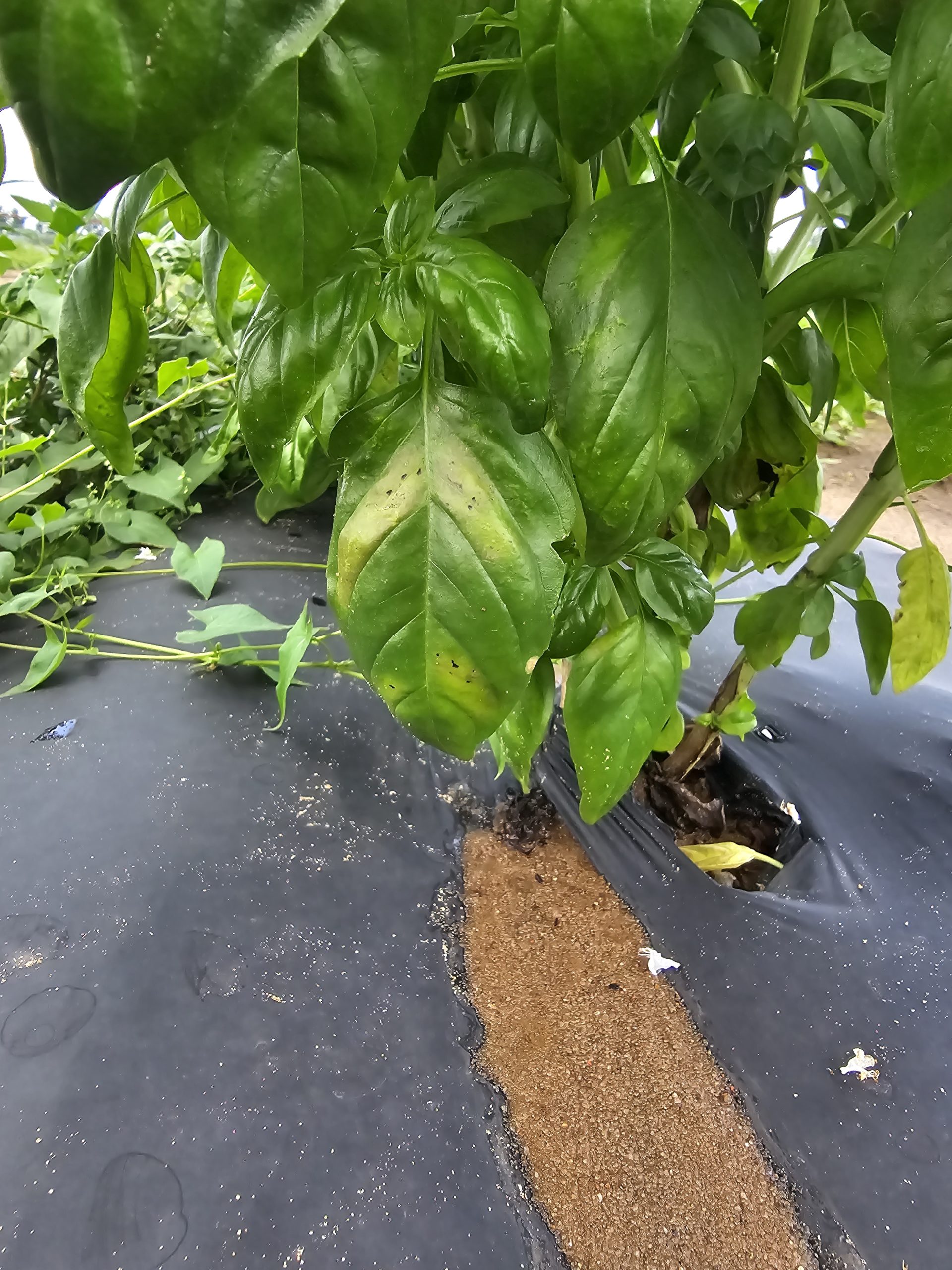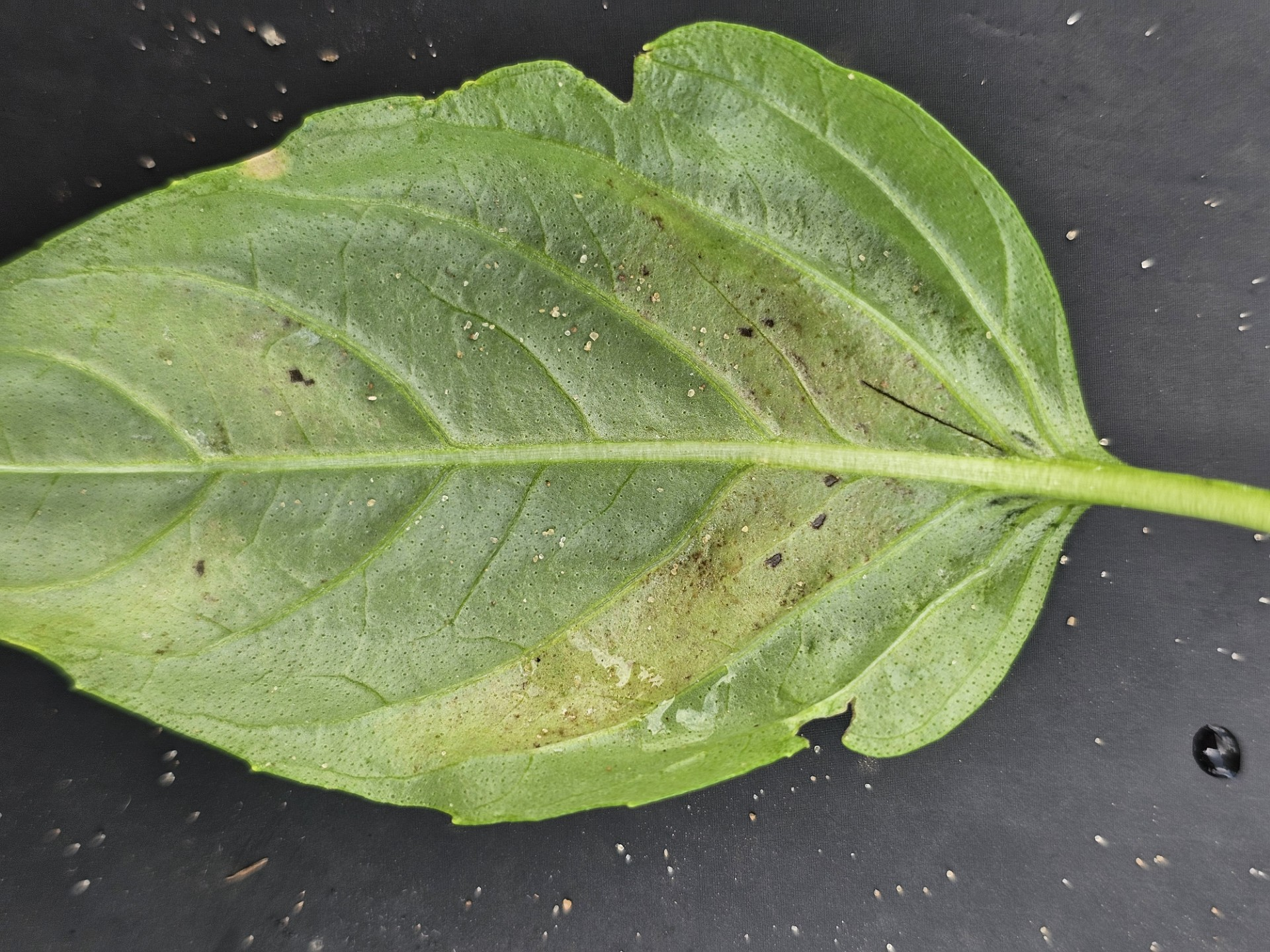
In this issue:
- Updates and management of Western bean cutworm and European corn borer insect pests in vegetables
- Disease forecasting updates for potato early blight and late blight
- Cucurbit downy mildew updates
- Basil downy mildew confirmations and management recommendations
Vegetable Insect Update – Russell L. Groves, Professor, UW-Madison, Department of Entomology, 608-262-3229 (office), (608) 698-2434 (cell), e-mail: rgroves@wisc.edu. Vegetable Entomology Webpage: https://vegento.russell.wisc.edu/
Western bean cutworm – (https://vegento.russell.wisc.edu/pests/).
Western bean cutworm adults are well into flight in southern Wisconsin, and it is important to scout for eggs. Weekly captures (Figure below, left) ending last Thursday (July 24) show a rapid increase from the week prior as evidenced by collections detailed by the Wisconsin Home Pest Survey. Please consult the WI Home Pest Survey site to see a more complete listing of the counties/cities where pheromone traps have confirmed significant numbers of adult moth activity over the past 7-10 days. In the same figure, the map (on the right) illustrates a cumulative capture of adult moths in pheromone traps up to July 24.
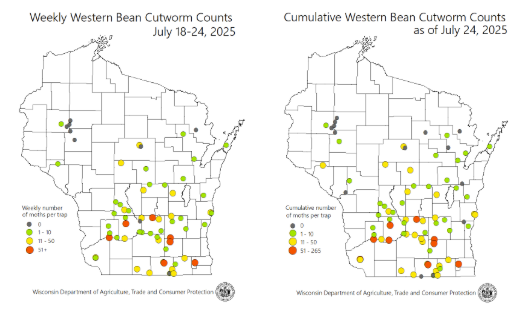
A majority of the elevated captures remain in south-central Wisconsin, but with continued warm temperatures (since July 24), adult moth activity is expected to increase throughout much of central Wisconsin and greater captures will continue to occur in northern regions. Foliar treatments are suggested when > 5% of the plants scouted possess an egg mass. On whorl stage corn, the best timing is to initiate applications when egg masses are dark colored which indicates that hatch will start soon and the corn has a developing ear that is forming.
When given a choice, adult females prefer pre-tassel corn to lay eggs upon because the pollen being shed is an important food source for larvae prior to moving to the ear.
Scouting suggestions:
- Infestations are often aggregated within a field so thorough field scouting is needed to find these pockets. Survey at least 5 different areas of a field and count egg masses on 20 consecutive plants in each of these 5 regions.
- Often eggs are found on the upper leaf surface on the uppermost leaves.
- Use the sun to backlight those leaves and look for the shadow of the egg mass(es).
- Later during the adult flight, also look for larvae that may have already hatched, and often these will be found in leaf axils feeding on pollen.
Included is an image of the western bean cutworm egg mass on Day 1 versus a week later when it is close to hatching. As seen in the image, egg masses are initially cream colored and then mature to become purple in color approximately 24-48 hours before they hatch. As is often the case with many caterpillars, newly hatched larvae consume the egg shell, so egg masses are most evident before or immediately after hatch.

Pheromone traps (see capture data included) are a good method to document the timing of adult emergence, but the magnitude of these captures do not always predict risk of injury within a field. Again, scouting for egg masses is the best predictor of damage. If corn is pollinating or silking during scouting, it is also a good idea to inspect the tassel and silk for early instar larvae. The Wisconsin Vegetable Disease and Insect Forecasting web-page corroborates the captures observed by the WI DATCP’s Home Pest Survey. From VDIFN, approximately 25% adult moth emergence is expected around 1320 FDD, peaking around 1420 FDD, and ending around 1535 FDD. Illustrated in the map inset below, the Wisconsin Dells region specifically has just surpassed the 1320 FDD threshold indicating the beginning of moth emergence, mating activity and egg deposition is expected to follow soon in these regions.
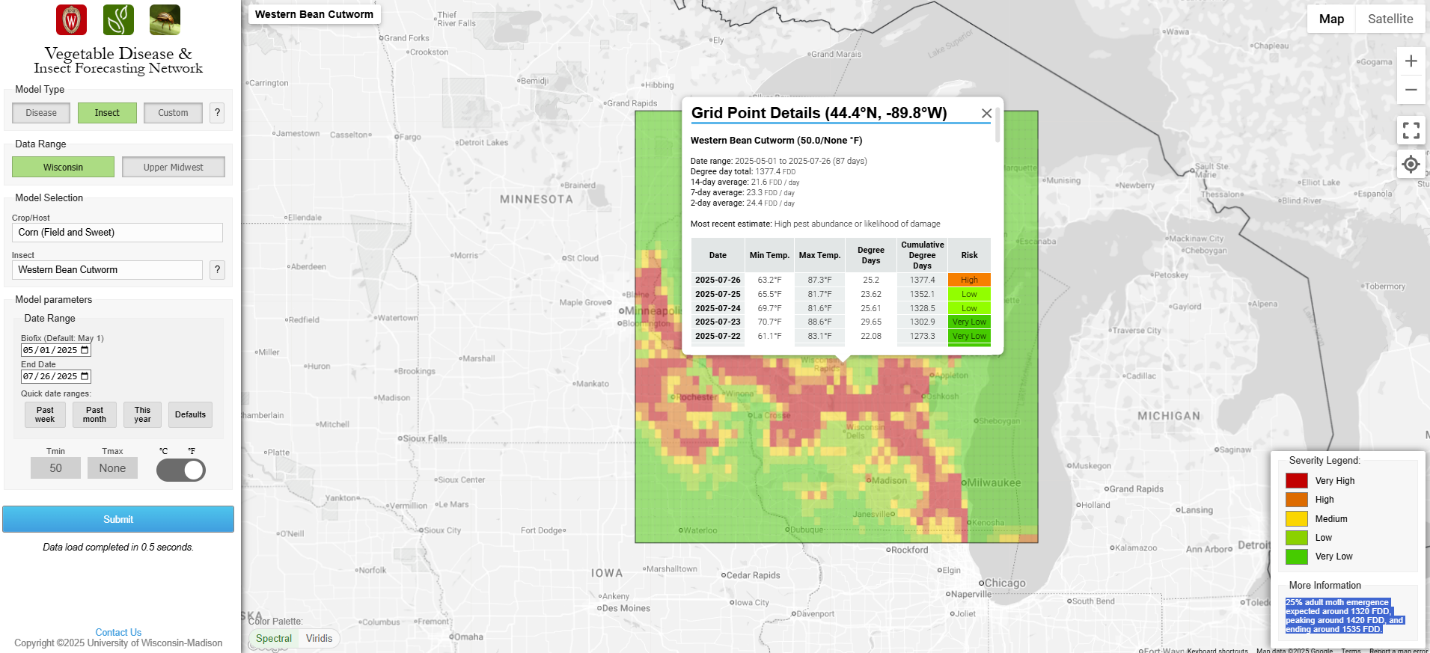
European corn borer – (https://vegento.russell.wisc.edu/pests/european-corn-borer/).
In most of Wisconsin, two generations of eggs are laid on susceptible crops. In early planted sweet corn and field corn, 1st generation larvae typically cause damage only to leaves and stalks, unless the corn is already tasseling, in which case the larvae will enter the ear. In Southern Wisconsin, begin checking early to mid-season sweet corn for egg masses in the next 7-10 days. Second generation larvae develop from eggs laid in early August and cause heavy infestations in mid- to late-planted corn, and corn that does not have a transgenic event.
Vegetable Disease and Insect Forecasting Network (VDIFN) map of risk for infestation by European corn borer, (ECB), https://agweather.cals.wisc.edu/vdifn (sourced 07/27/2025). Notice areas within the ‘orange or red shaded’ zones indicate high risk zone for adult moth oviposition, and these remain just to our south currently, but will be advancing into the state in the week to come. Sweet corn and green bean producers with susceptible crop stages (silking corn, pin-bean stage green bean) should be scouting for these mobile insects.
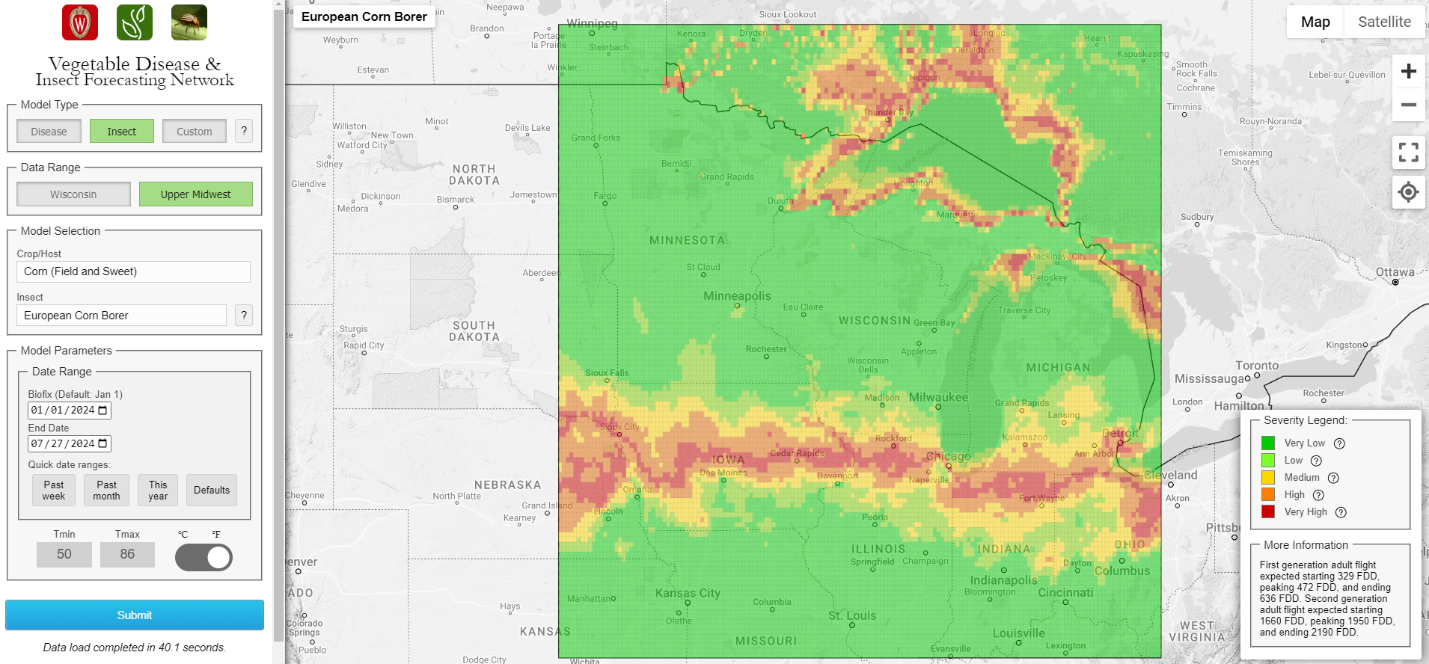
Scouting hints – Fresh market sweet corn:
- Fresh market sweet corn in southern Wisconsin may be tasseled in late June when egg masses for the first-generation borers start to hatch. Monitoring for early evidence of borer attack is crucial as treatments must be properly timed to keep the developing ears essentially free of borers.
- Blacklight traps attract moths and can help you monitor population intensity and activity. Contact your county Extension office for trap data.
- Begin checking plants for egg masses by June 15 in southern Wisconsin. Examine 10 plants in at least five different areas.
- Through early silk stage, treat if 5% of the plants have egg masses, larvae, or leaf-feeding damage.
- Repeat treatment every 3-5 days if more than one unhatched egg mass remains per 20 plants.
Scouting hints – Processing sweet corn:
- Second-generation borers attack late-planted processing corn. Blacklight insect traps provide useful records in June for first flight, and are even more worthwhile in August for monitoring the second flight. Scout areas that have different planting dates or varieties separately because these differences can affect the extent of egg laying.
- Scout ever 5-7 days. Sample at least 10 plants in each of five areas of a field.
- Examine leaves for egg masses and larvae; also look on husk leaves arising from the ear tip.
- Check emerging tassels and in leaf collars for larvae; treat if you find live larvae or eggs on 4-5% of the plants.
- Repeat treatments every 3-5 days if you continue to find live larvae or eggs on 4-5% of the plants. Two to three applications may be necessary during years with heavy infestations.
From the Wisconsin Home Pest Survey, adult captures remain very low for ECB at this time and this is consistent with the map predictions from VDIFN. Remain vigilant, however, as infestation risk will change rapidly over the coming 10-14 days as we move into August.
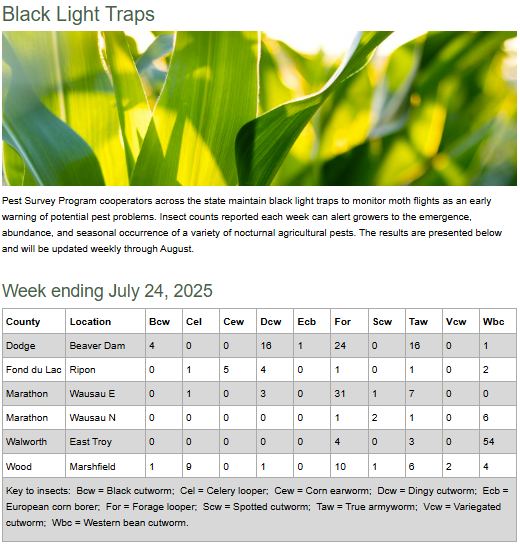
Amanda Gevens, Professor & Extension Vegetable Pathologist, UW-Madison, Dept. of Plant Pathology, 608-575-3029, gevens@wisc.edu, Lab Website: https://vegpath.plantpath.wisc.edu/.
Current P-Day (Early Blight) and Disease Severity Value (Late Blight) Accumulations will be posted at our website and available in the weekly newsletters. Thanks to Ben Bradford, UW-Madison Entomology for supporting this effort and providing a summary reference table: https://agweather.cals.wisc.edu/thermal-models/potato. A Potato Physiological Day or P-Day value of ≥300 indicates the threshold for early blight risk and triggers preventative fungicide application. A Disease Severity Value or DSV of ≥18 indicates the threshold for late blight risk and triggers preventative fungicide application. Data from the modeling source: https://agweather.cals.wisc.edu/vdifn are used to generate these risk values in the table below. I’ve estimated early, mid-, and late planting dates by region based on communications with stakeholders. These are intended to help in determining optimum times for preventative fungicide applications to limit early and late blight in Wisconsin.
|
|
Planting Date | 50% Emergence Date | Disease Severity Values (DSVs)
through 7/26/2025 |
Potato Physiological Days (P-Days)
through 7/26/2025 |
|
| Spring Green | Early | Apr 5 | May 10 | 33 | 599 |
| Mid | Apr 18 | May 14 | 33 | 571 | |
| Late | May 12 | May 26 | 30 | 514 | |
| Arlington | Early | Apr 5 | May 10 | 27 | 600 |
| Mid | Apr 20 | May 15 | 27 | 563 | |
| Late | May 10 | May 24 | 24 | 527 | |
| Grand Marsh | Early | Apr 7 | May 11 | 33 | 583 |
| Mid | Apr 17 | May 14 | 33 | 564 | |
| Late | May 12 | May 27 | 33 | 510 | |
| Hancock | Early | Apr 10 | May 15 | 35 | 551 |
| Mid | Apr 22 | May 21 | 35 | 525 | |
| Late | May 14 | June 2 | 35 | 470 | |
| Plover | Early | Apr 14 | May 18 | 31 | 527 |
| Mid | Apr 24 | May 22 | 31 | 524 | |
| Late | May 19 | June 7 | 31 | 427 | |
| Antigo | Early | May 1 | May 24 | 34 | 482 |
| Mid | May 15 | June 1 | 34 | 451 | |
| Late | June 1 | June 15 | 29 | 363 | |
| Rhinelander | Early | May 7 | May 25 | 24 | 468 |
| Mid | May 18 | June 8 | 24 | 390 | |
| Late | June 2 | June 16 | 19 | 348 | |
Late blight of potato/tomato. In the US, late blight has been confirmed on tomato in Cattaraugus County, NY on July 18. The infection was reported to affect 100% of a susceptible tomato variety, while a resistant variety was less affected. This follows after the July 17 Dufferin County Ontario Canada finding, which was confirmed as US-23 Phytophthora infestans (still sensitive to mefenoxam/metalaxyl (ie: Ridomil). https://onvegetables.com/2025/07/17/late-blight-update-july-17th-2025/ Late blight was not reported in any other commercial potato or tomato field in Ontario since the initial July 17 finding. Cornell Extension has reported late blight confirmations on potatoes and tomatoes in western NY following the July 18th finding. https://www.wrfalp.com/late-blight-found-in-cattaraugus-county-affects-tomatoes-potatoes/
The usablight.org website (https://usablight.org/map/ now using Plant Aid) indicates no new confirmed reports of late blight on tomato or potato in the US this past week. There was a US-23 late blight strain type confirmation in Collier County FL in 2025 (now > 2 months old). The site is not comprehensive.
Here in Wisconsin, we saw the accumulation of 1-14 DSVs across WI this past week, with the greatest accumulations in the Antigo growing area. All plantings of potatoes in Wisconsin have surpassed the Blitecast threshold of 18 DSVs and should receive preventative fungicides for the management of late blight. Please find a fungicide listing for Wisconsin potato late blight management: https://vegpath.plantpath.wisc.edu/documents/potato-late-blight-fungicides/
Early blight of potato. Accumulations of P-Days were 59-63 over the past week, with P-Day 300 thresholds met for preventative fungicide treatment in potatoes across all of Wisconsin. The earliest inoculum of Alternaria solani typically comes from within a field and from nearby fields. Once established, early blight continues to create new infections due to its polycyclic nature – meaning spores create foliar infection and the resulting lesion on the plant can then produce new spores for ongoing new infections in the field and beyond. Early-season management of early blight in potato can mitigate the disease for the rest of the season, especially since the earlier sprays tend to get best coverage and potential control of early infection. Early blight is active in central and southern WI. https://vegpath.plantpath.wisc.edu/diseases/potato-early-blight/
Fungicides can provide good control of early blight in vegetables when applied early in infection. Multiple applications of fungicide are often necessary to sustain disease management to the time of harvest due to the typically high abundance of inoculum and susceptibility of most common cultivars. For Wisconsin-specific fungicide information, please refer to the Commercial Vegetable Production in Wisconsin (A3422), a guide available here: https://cropsandsoils.extension.wisc.edu/articles/2025-commercial-vegetable-production-in-wisconsin-a3422/
For custom values, please explore the UW Vegetable Disease and Insect Forecasting Network tool for P-Days and DSVs across the state (https://agweather.cals.wisc.edu/vdifn). This tool utilizes NOAA weather data. Be sure to enter your model selections and parameters, then hit the blue submit button at the bottom of the parameter boxes. Once thresholds are met for risk of early blight and/or late blight, fungicides are recommended for optimum disease control. Fungicide details can be found in the 2025 Commercial Veg. Production in WI Extension Document A3422: https://cropsandsoils.extension.wisc.edu/articles/2025-commercial-vegetable-production-in-wisconsin-a3422/
Cucurbit Downy Mildew: This national cucurbit downy mildew information helps us understand the potential timing of arrival of the pathogen, Pseudoperonospora cubensis, in our region, as well as the strain type which can give us information about likely cucurbit hosts in WI – as well as best management strategies. Clade 1 downy mildew strains infect watermelon and Clade 2 strains infect cucumber. I am hosting a cucurbit (and basil) downy mildew sentinel plot at the UW Hancock Agricultural Research Station this summer. This ‘sentinel plot’ is a non-fungicide-treated collection of cucurbit plants observed weekly for disease symptoms. No downy mildew was seen on cucurbits this past week at HARS. Additionally, I keep an eye on the downy mildew work of Dr. Mary Hausbeck at Michigan State University and include this information as relevant to WI https://veggies.msu.edu/downy-mildew-news/. This season, Clade 2 downy mildew spores were confirmed in several MI counties and downy mildew has been confirmed in commercial cucumber fields in several MI counties. The disease was also reported in northern Ohio, Pennsylvania, Kentucky, and Alabama this past week on cucumber. The Cucurbit Downy Mildew ipm PIPE website still maintains current reports: https://cdm.ipmpipe.org/ and I included a picture below of the current positive reports indicated by the red counties. Green coloration indicates a report of over one week ago.
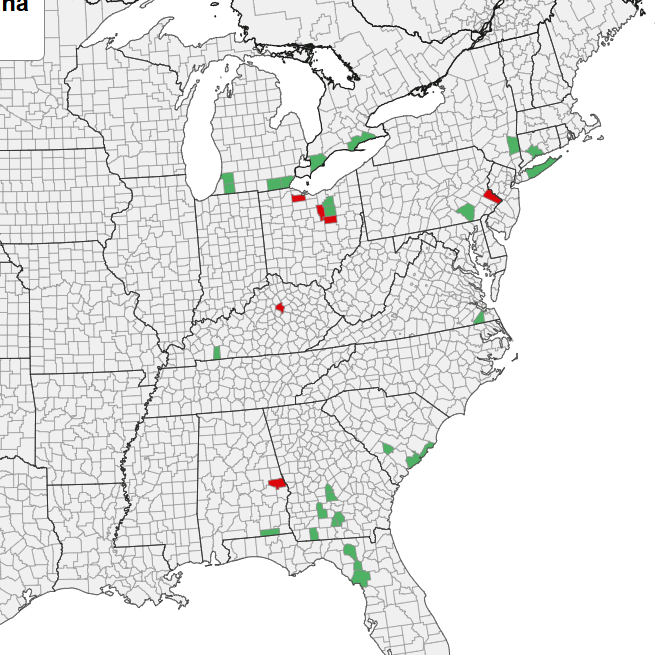
Basil Downy Mildew has been confirmed in both Columbia and Dane Counties, Wisconsin, this past week. (I credit elements of the content below to Drs. Brian Hudelson, of our UW Plant Disease Diagnostic Clinic, and Marian Lund, alumnus of Plant Pathology). https://pddc.wisc.edu/2016/10/14/basil-downy-mildew/. Basil downy mildew is a devastating disease caused by the water mold or oomycete pathogen Peronospora belbarii that affects the leaves, branches, and stems of many types of basil (i.e., plants in the genus Ocimum), plants commonly used for cooking. Green-leafed varieties of sweet basil are particularly susceptible to the disease, while purple-leafed varieties of basil, Thai basil, lemon basil, and spice basil are less susceptible. Certain ornamental basils (e.g., hoary basil) appear to be highly resistant to the disease. Basil downy mildew was first reported in the United States in 2007 and has since spread widely to wherever basil is grown, including Wisconsin – with our first confirmation of the disease in 2010.
Symptoms of basil downy mildew typically develop first on lower leaves (picture below), but eventually, an entire plant will show symptoms. Initial symptoms include leaf yellowing (which can mimic nitrogen deficiency) followed by leaf browning. Affected leaves also curl and wilt, and on the undersides of the leaves, a gray-purple fuzzy material will develop. This pathogen can be easily introduced into a garden/farm each year via contaminated seed, on infected transplants, or via wind-borne spores. Once introduced into a garden/farm the pathogen can spread by wind, by rain splash, or via items (e.g., hands, clothing, garden tools) that come into contact with infected plant and then are used to work with healthy plants. The pathogen thrives in humid, warm environments and can spread rapidly, decimating an entire basil crop.
If you see basil downy mildew, there are some fungicide options to limit further development and spread of the pathogen, but for the home gardener, it may be best to harvest any asymptomatic leaves on infected plants, as well as other healthy basil plants in your garden and use immediately. In the coming years, try growing resistant varieties (ie: Eleonora and now several others). If you grow basil from seed, check to see if the seed you are buying has been steam-treated to kill the downy mildew pathogen. More information https://www.vegetables.cornell.edu/pest-management/disease-factsheets/basil-downy-mildew/ Whatever type of basil you choose, try to grow your plants in a manner that will keep the plants as dry as possible, thus creating an environment that is less favorable for the downy mildew pathogen to develop and infect. good airflow and rapid drying of plants when they get wet. Avoid overhead watering (e.g., with a sprinkler) that will wet leaves and spread the pathogen; instead, use a drip or soaker hose to water.
Some varieties have been found to be less susceptible. Red basil (‘Red Leaf’ and ‘Red Rubin’), Thai basil (Queenette’), lemon basil (‘Lemon,’ ‘Lemon Mrs. Burns,’ ‘Sweet Dani Lemon Basil’), lime basil (‘Lime’), and spice basil (‘Spice,’ ‘Blue Spice,’ ‘Blue Spice Fil,’ ‘Cinnamon’), presented less severe downy mildew symptoms in a previous study. Sweet basil varieties with resistance to downy mildew include: Rutgers Obsession DMR, Rutgers Devotion DMR, Rutgers Passion DMR, and Rutgers Thunderstruck.
Application of fungicides can be useful in managing basil downy mildew. Active ingredients including: cyazofamid (Ranman 3.6SC), mandipropamid (Revus), phosphorous acid (ProPhyt); base protectants including chlorothalonil and copper can be useful in early prevention of disease.
Organic products including Actinovate (a. i. Streptomyces lydicus), Double Nickel 55 (a. i. Bacillus amyloliquefaciens), MilStop (a. i. potassium bicarbonate), Regalia (a. i. Reynoutria sachalinensis), Trilogy (a. i. neem oil), and OxiDate (a. i. hydrogen dioxide) are labeled for basil, however, these are generally not highly effective.
Products containing the active ingredients copper or chlorothalonil are the best and only effective products available to home gardeners (can be sold as ‘Daconil’). In addition, home gardeners should grow varieties with tolerance if they are worried about basil downy mildew in future years because most chemicals available to the home gardener are not sufficient to control basil downy mildew once it appears. Once plants are infected in a home garden, there is little that can be done to protect them besides weekly fungicide sprays.
